Text
UV lamps in nails salon
Hello!
Just yesterday, I saw an article with this headline:

It caught my attention because, in Spain, where I currently live, it is fashionable to go to the nail salon every 2 weeks and have a perfect manicure.
The article discusses how UV lamps used to dry nails can cause DNA alterations and cell death. In addition, they found that a single 20-minute session led to 20-30% of cell death, and 3 consecutive 20-min exposures caused 65-70% of cell death. These UV lamps use a wavelength of 340 to 395 nm.
Higher levels of somatic mutations were revealed in the irradiated cells, with similar patterns in skin cancer patients.
Do you guys get frequent manicures? I'll read you in the comments.
#scientific writing#UV#chemistry#nails care#nailcare#medical writing#nature communications#dna damage#cell death#scientists#science
9 notes
·
View notes
Text
Working in progress

Since I work as a medical writer, I only have a little time to write here. But I have some things to show you. So you will see it soon.
1 note
·
View note
Text
Qutenza-capsaicin
Hey, hey, hey!
It's been a while since I wrote because my life has been in chaos, and I've started a new job as a medical writer.
On Tuesday, I get a Qutenza patch to reduce/eliminate the peripheral neuropathic pain I have in my face due to a transplant.
What is peripheral neuropathic pain?
Mayo Clinic tells us:
Peripheral neuropathy, a consequence of damage to nerves outside the brain and spinal cord (peripheral nerves), often causes weakness, numbness and pain, usually in the hands and feet. It can also affect other areas and body functions, such as digestion, urination and circulation.
The peripheral nervous system sends information from the brain and spinal cord (central nervous system) to the rest of the body. The peripheral nerves also send sensory information to the central nervous system.
Peripheral neuropathy can result from traumatic injuries, infections, metabolic problems, hereditary causes and exposure to toxins. One of the most common causes is diabetes.
People with peripheral neuropathy usually describe the pain as shooting, burning or tingling. In many cases, symptoms improve, especially if the cause is a treatable condition. Medications can reduce the pain of peripheral neuropathy.
In my case, the pain I feel is shooting and burning. It is a senseless pain, pain for pain's sake.
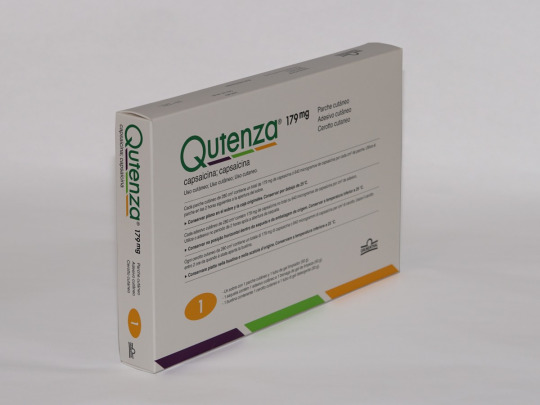
But why Qutenza?
Qutenza contains capsaicin 8%. Yes, that's what you're thinking; it's the compound in hot chili peppers. Its action consists of affecting the nerve cells in the skin that are associated with pain, which causes a decrease in the activity of these nerve cells and a reduced sensation of pain.
At the hospital, first, they stick the patch on my face transplant for 60 minutes, and I must endure that shooting pain from the capsaicin. Then they clean me well, and I have to put ice on my face for a whole day.
The next day I wake up with no pain, and so on for almost 90 days. Unfortunately, I have to repeat the procedure every 4 months because the pain gradually increases as the capsaicin wears off.
Did you know about this treatment?
Then, on Tuesday or Wednesday, if I have strength left after the patch, I will make a small post about the experience of the patch in winter since it is the first time it coincides and the effects can be better.
0 notes
Text
Today, I saw this post, and as a chemist, I advised you not to add sugar to tea.

In my opinion, it's disgusting, hahaha.
chemistea
Adding sugar to tea impacts the intermolecular forces within the mixture. The hydrophobic moieties on sugar stack against the face of the caffeine ring, and this clumping results in less free caffeine. The reduction in surface area results in reduced interaction with your taste receptors, which is why tea tastes different, and not just sweeter, when you add sugar.
53 notes
·
View notes
Text
CANNABIS
Today we are going to talk about a well-known drug:
Marijuana or Cannabis Sativa has been known as a drug of abuse due to its psychoactive effects for over 50 centuries. However, it was not until 1964 that the plant's main psychoactive compound, THC, was isolated and characterized. From there, the various constituents of Cannabis were isolated, and the biological targets that are part of the ECS (Endocannabinoid System) were identified. The ECS is a therapeutic target involved in various physiological processes.

Currently, two types of receptors belonging to the SEC have been identified: CB1 and CB2.
CB1 is mainly located in the CNS. It is known that the psychotropic effects of Cannabis come from the activation of CB1 receptors in the brain.
CB2 receptors in the immune system, it has been proposed that the activation of these receptors could be the cause of the immunosuppressive properties of marijuana.
Finally, GPR55 and GPR18 are known as possible members of the SEC, but this categorization has yet to be confirmed due to the lack of pharmacological profiles.

One of the constituents of Cannabis, as shown in the image above, is CBD, which is free of psychotropic effects and shows many therapeutic properties.

Did you know about the properties of CBD? Without judgment of any kind, do you use it in your daily life? I'll read you in the comments.

Hoy vamos a hablar de un gran conocido:
La marihuana o Cannabis Sativa se conoce como droga de abuso debido a sus efectos psicoactivos desde hace más de 50 siglos. No fue hasta 1964 que se aisló y caracterizó el principal compuesto psicoactivo de la planta, el THC. A partir de aquí, se aislaron los distintos constituyentes del Cannabis y se identificaron las dianas biológicas que forman parte del SEC (Sistema endocannabinoide). Éste es una diana terapéutica involucrada en diversos procesos fisiológicos.

Actualmente, se han identificado dos tipos de receptores pertenecientes al SEC: CB1 y CB2
CB1 se localiza principalmente en el SNC, Se conoce que los efectos psicotrópicos del cannabis provienen de la activación de los receptores CB1 en el cerebro.
CB2 en el sistema inmune, se ha propuesto que la activación de dichos receptores podría ser la causa de las propiedades inmunosupresoras de la marihuana.
Por último, se conoce GPR55 y GPR18 como posibles miembros del SEC, pero esta categorización no ha sido confirmada debido a la falta de perfiles farmacológicos.

Uno de los constituyentes del Cannabis, como se ha mostrado en la imagen anteriormente, es el CBD, el cual está exento de efectos psicotrópicos y muestra muchas propiedades terapéuticas.

¿Sabíais de las propiedades del CBD? Sin juicios de ningún tipo, ¿lo utilizáis en vuestro día a día? Os leo en comentarios.
1 note
·
View note
Text
No post today because I have caught either a virus or bacteria. Crazy times these days.
Hoy no hay post porque he cogido o un virus o una bacteria. Tiempos locos los que corren.
Image: a funnel extraction with some weird liquids.

0 notes
Text
Normal life? - ¿Vida normal?
I end the topic of vaccines with this image:
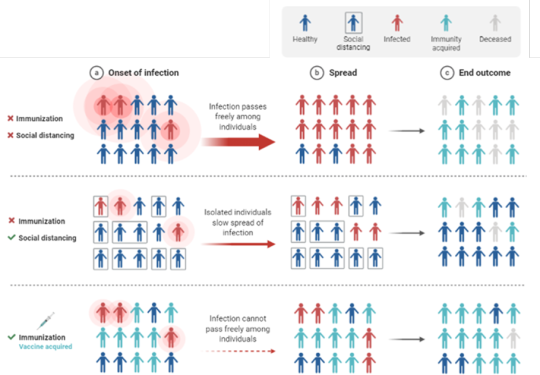
After two years of the pandemic, we can say that science is helping us live better. Thanks to the vaccines, we have regained the life we lost in 2020.
Most of us have opted for the good of the community to make possible a life living with this new virus. Moreover, we have been molding our life to unique situations, sometimes better and sometimes worse, but we have always been moving forward.
How was your 2020? I read you in the comments.

Finalizo el tema de vacunas con esta imagen:

Después de dos años de pandemia, podemos decir en voz alta que la ciencia nos ayuda a vivir mejor. Gracias a las vacunas, hemos vuelto a vivir esa vida que perdimos en 2020.
La mayoría hemos optado por el bien hacia la comunidad para hacer posible una vida conviviendo con este nuevo virus. Además, hemos ido moldeando nuestra vida a la nueva situación, a veces mejor y a veces peor pero siempre hemos ido avanzando.
¿Cómo vivisteis vuestro 2020? Os leo en comentarios
0 notes
Text
Types of vaccines - Tipos de vacunas
Continuing with vaccines and almost finishing this topic. I will leave you a list of the current vaccine types and some references for further investigation.

Do you know of any other types? I'll read you in the comments.
References:
Afrough B.; Dowall S.; Hewson R., Clin Exp Immunol. 2019,196(2):157-166.
Graham BS.; Ledgerwood JE.; Nabel GJ., Clin Pharmacol Ther. 2009;86(3):234-6.
Graham BS., Immunol Rev. 2013;255(1):230-42

Siguiendo con las vacunas y casi terminando este tema. Os dejo una lista de los tipos de vacunas que existen a día de hoy y un poco de bibliografía para que indaguéis un poco más.

¿Conocéis algún tipo más? Os leo en comentarios.
Bibliografía:
Afrough B.; Dowall S.; Hewson R., Clin Exp Immunol. 2019,196(2):157-166.
Graham BS.; Ledgerwood JE.; Nabel GJ., Clin Pharmacol Ther. 2009;86(3):234-6.
Graham BS., Immunol Rev. 2013;255(1):230-42
1 note
·
View note
Text
Developing a vaccine – Desarrollando una vacuna
Previously I wrote about drug development. Today it is time for vaccine development.
Traditional method
In summary and as we discussed in the previous post, in preclinical stages, efficacy and toxicology, among other properties, are verified. Afterward, our drug candidate goes to clinical phases, the regulatory agencies approve it, and it starts to be distributed.

SARS-CoV-2 vaccines
The development of vaccines currently known to combat COVID is quite different from the traditional one. Due to the pandemic we were experiencing in 2020, the traditional method of vaccine development was changed a bit to be fast and effective.
Thanks to the scientific community turning to scientific dissemination about everything related to this new virus, we were able to have prototype vaccines in a matter of months. Phases I, II and III overlapped to make a refined vaccine available to the population as soon as possible. In a matter of months, the regulatory agencies approved the new vaccines and made them available to the entire population.

Now the remaining challenge is to optimize and refine them to prevent transmission. Did you know this?

Anteriormente escribí sobre el desarrollo de fármacos. Hoy es hora del desarrollo de vacunas.
Método tradicional
En resumen y como ya hablamos en el post anterior, en etapas preclínicas se verifica la eficacia y la toxicología, entre otras propiedades. Después, nuestro candidato a fármaco para a las fases clínicas y después las agencias reguladoras lo aprueban y se comienza a distribuir.

Vacunas de SARS-CoV-2
El desarrollo de las vacunas que actualmente conocemos para combatir la COVID es bastante distinto al tradicional. Debido a un estado de alarma por la pandemia que vivimos en 2020, el método tradicional de desarrollo de vacunas se cambió un poco para ser rápidos y eficaces.
Gracias a que la comunidad científica se volcó en la divulgación científica sobre todo lo relacionado a este nuevo virus, en cuestión de meses pudimos tener prototipos de vacunas. Las fases I, II y III se solaparon para obtener un a vacuna refinada disponible cuanto antes para la población. En cuestión de meses, las agencias reguladoras aprobaron las nuevas vacunas y las pusieron disponibles para toda la población.

Ahora el desafío que queda es optimizar y refinarlas para que eviten la transmisión. ¿Sabíais esto?
0 notes
Text
Developing a vaccine or a drug – Desarrollando un medicamento o una vacuna
In these next few days, I will easily write some publications about vaccines and drug development.
Before a drug or vaccine is marketed or tested in the human population, there are several previous stages.
First, there is a previous stage of research and discovery, in which therapeutic targets are identified, validation of these targets, development of biological assays, synthesis of organic compounds or optimization of structures, among others. Then, a Hit (a compound with activity in primary biological assay) is obtained and optimized to get a Lead (a compound with confirmed biological activity). With this Lead, the preclinical trials begin, whether in vitro, ex vivo, in vivo or in silico, where toxicity, efficacy, selectivity, mechanism of action, etc., are tested.
In vitro, Ex vivo: in isolated organs and tissues, cell cultures, cell fragments, receptors, ion channels or enzymes.
In vivo: animal studies.
In silico: by computer simulation.
From this point on, if the drug works, an application for authorization of clinical trials is made. The clinical development stage begins with the known phases I, II, and III.
Phase I: tolerance, pharmacology, ADME.
Phase II: efficacy, selectivity.
Phase III: clinical benefit, adverse effects.
After Phase III and verifying that the drug is safe, a marketing application is made. In this last stage, the regulatory agencies play a significant role in approving the drug in the country where they work.
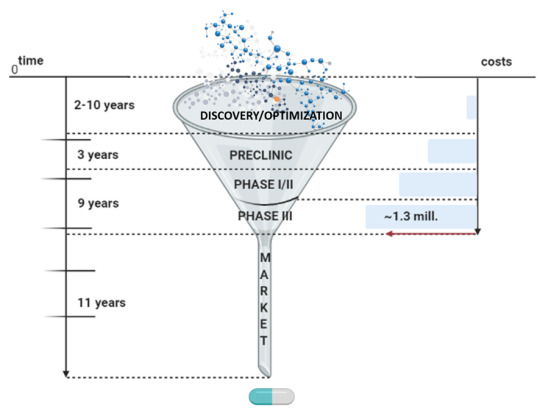
As you can see in the picture, this process usually takes 11 years. So, the next time you question the drug development method, think about the above graph.
In the next post, I will discuss traditional vaccine development and the comparison with SARS-CoV-2.

Estos próximos días vengo con unas publicaciones relacionadas con las vacunas y desarrollo de fármacos de una manera fácil de comprender.
Antes de que un fármaco o vacuna salga al mercado o se testee en la población humana hay varias etapas anteriores.
Primero hay una etapa previa de investigación y descubrimiento, en el que se identifican dianas terapéuticas, validación de estas dianas, desarrollo de ensayos biológicos, síntesis de compuestos orgánicos o optimización de estructuras, entre otros. Se obtiene de esta manera, un Hit (compuesto con actividad en ensayo biológico primario) que se optimiza para obtener un Lead (compuesto con actividad biológica confirmada). Con este Lead se comienzan los ensayos preclínicos ya sean in vitro, ex vivo, in vivo o in silico, donde se comprueba la toxicidad, eficacia, selectividad, mecanismo de acción, etc.
In vitro, Ex vivo: en órganos y tejidos aislados, cultivos celulares, fragmentos celulares, receptores, canales iónicos o enzimas.
In vivo: estudios en animales.
In silico: mediante simulación informática.
A partir de este momento si el medicamento funciona, se realiza una solicitud de autorización de ensayos clínicos y se comienza la etapa de desarrollo clínico con las ya conocidas fases I, II, III.
Fase I: tolerancia, farmacología, ADME.
Fase II: eficacia, selectividad.
Fase III: beneficio clínico, efectos adversos.
Después de la fase III y haber comprobado que el fármaco es seguro, se realiza una solicitud de comercialización. En esta última etapa las agencias reguladoras toman un papel muy importante para la aprobación del medicamento en el país en el que trabajen.

Como se observa en la foto todo este proceso suele durar de media 11 años. Así que la próxima vez que queráis poner en duda el método de desarrollo de un fármaco, pensad en el gráfico anterior.
En el próximo post hablaré del desarrollo de vacunas tradicional y la comparación con las de SARS-CoV-2.
#science#scientific writing#drug development#drug discovery#vaccine#phase I#Phase II#Phase III#preclinical
0 notes
Text
Do chemical compounds taste good?
Taste is a very personal thing, and today I come to tell you how potassium cyanide tastes, since we had a wrong idea about its taste. In all the literature about potassium cyanide (KCN), you can read that its taste resembles bitter almonds. But in reality, it is harsh and spicy, acrid. As we know, a pinch of this white solid is enough to kill you instantly.
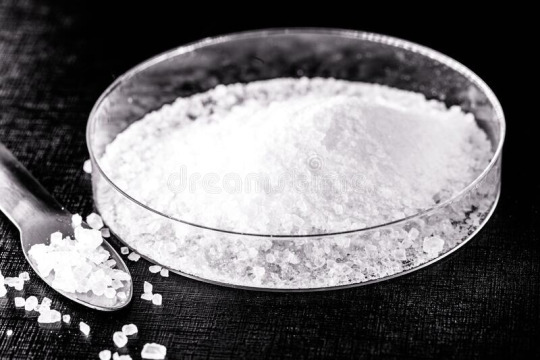
One man in India committed suicide by hastily leaving a note describing the specific taste of KCN.
The note read:
Doctors, potassium cyanide. I have tasted it. It burns the tongue and tastes acrid.
In 2006, this man checked into a hotel, mixed KCN with alcohol and shook it with the pen with which he was going to write the suicide note. He accidentally introduced the pen in his mouth and quickly wrote the above before he died. He did not have time to write more.
This suicide note is a written document about the taste of cyanide and what to consider when describing it. The scientific community remains divided on the taste of KCN, even with evidence like this. But why is a piece of scientific evidence so precise and not repeatable, not taken to change the current literature? Any ideas? I'll read you in the comments!
7 notes
·
View notes
Text
Today I'm reblogging this because it’s going to be funny. Hoy reblogueo esto porque creo que será divertido.
Reblog and put in the tags what country you live in and how you feel about it
#spain#we have a left party in the government doing nothing for the people#Our government doesn't want to approved a TRANS law#The TRANS law is perfect#No comments about TRANS law if you aren't trans#I live in the most multicultural city in Spain#even if I live in a multicultural city I see some xenophobic people every day#our public health system is the best of europe#but people are going out of Spain because of the low salary#scientits normally emigrate to another european country to live and work#I love the different languages that people speak in the country#most people don't speak English#But I love Spain above any other European country#no more ideas about this publication sorry#someone more Spanish than me to do the reblog?#españa
1K notes
·
View notes
Text
San Alberto Magno - Albertus Magnus
Hoy es el día tan esperado: San Alberto Magno, patrón de los químicos o ciencia. Fue obispo de la iglesia católica pero también químico, o al menos la química que se conocía en aquel entonces, ALQUIMIA. Acercó la ciencia a la iglesia, la cual estaba eones alejada de todo el conocimiento científico. Su contribución a la ciencia le otorgó el título de santo de las ciencias naturales.
¡Pero no vengo a hablaros de él!
Hace 5 años en este día 15 de noviembre, tuve un accidente en un laboratorio de química orgánica donde trabajaba. Hace 5 años mi vida cambió y mi mentalidad también. Fue un accidente bastante grave. Una jeringa en mal estado con 1 mL de ácido trifluoroacético (TFA) me estalló con tal mala suerte que me dio en la tripa, pecho y cara. Tras varias operaciones, curas, trasplantes de piel en la cara y casi 2 meses en cuidados intensivos, salí del hospital con una vida nueva que cuidar.
Han sido y siguen siendo los peores años de salud de mi vida. Debido a la gravedad de las heridas, a día de hoy sigo con efectos secundarios. Pero sigo apostando por la ciencia cada día. Me apunto a cualquier tratamiento/ensayo clínico que hay, ya que confío en el método científico al 100%. Y también, mi actitud frente a esta nueva situación ha sido siempre de seguir hacia adelante, aunque dándome espacio para mirar a atrás.
Me reafirmo en la ciencia, pero el 15 de noviembre es un día místico para mí. Llevo tatuado ese día en forma de estrella fugaz, como se ve en la foto. Es un diseño de Carlos Sadness, un cantante español que hizo tatuaje una de las canciones que más han significado para mí, Perseide. Este tatuaje está realizado en línea fina, lo que quiere decir es que se irá con el tiempo hasta casi desaparecer, al igual que mi sueño de que desaparezca todo el dolor y la cicatriz que queda en mi cara.
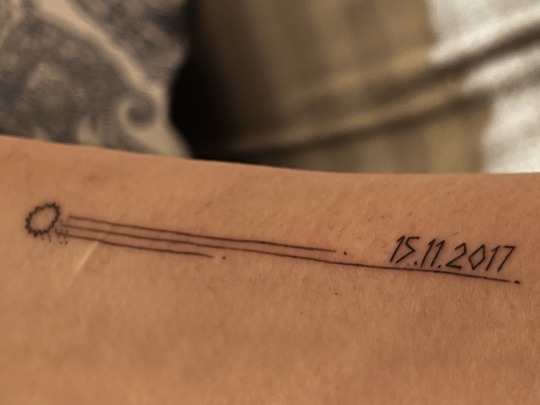
La ciencia avanza y yo avanzo con ella.
Hoy el post en español va primero, ya que este escrito lo hago desde el fondo de mi corazón.
¡Feliz día de San Alberto!
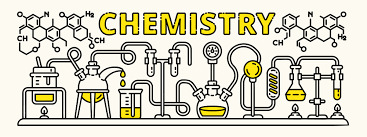
Today is the long-awaited day: St. Albert the Great, patron saint of chemists or science. He was a bishop of the Catholic Church and a chemist, or at least the chemistry that was known at that time, ALCHEMY. He brought science closer to the church, which was eons away from all scientific knowledge. His contribution to science earned him the title of the saint of the natural sciences.
But I am not here to tell you about him!
Five years ago, on November 15, I had an accident in an organic chemistry laboratory where I was working. Five years ago, my life changed, and so did my mentality. It was quite a severe accident. A wrong syringe with 1 mL of trifluoroacetic acid (TFA) burst with such bad luck that it hit me in my stomach, chest and face. After several operations, cures, skin transplants on my face and almost 2 months in intensive care, I left the hospital with a new life to take care of.
They have been and continue to be the worst health years of my life. Due to the severity of the wounds, to this day, I still have side effects. But I am still committed to science every day. I sign up for any treatment/clinical trial as I trust the scientific method 100%. And also, my attitude towards this new situation has always been to move forward, although giving myself room to look back.
I reaffirm myself in science, but November 15 is a magical day for me. I have a tattoo of that day in the shape of a shooting star, as you can see in the photo. It is a design by Carlos Sadness, a Spanish singer who tattooed one of the songs that have meant the most to me, Perseid. This tattoo is made in fine lines, which means it will go away with time until it almost disappears, just like my dream that all the pain and the scar on my face will disappear.

Science advances, and I advance with it.
Today the Spanish post goes first, as this writing is from the bottom of my heart.
Happy St. Albertus' Day!
#science#ciencia#scientific writing#november 15#alberto magno#albertus magnus#chemistry#quimica#tattoos#carlos sadness#perseides#new life#accidents#laboratory#accidente
2 notes
·
View notes
Text
Werner’s dream - El sueño de Werner
Alfred Werner was born in Mulhouse, Germany. Chemist and professor at the University of Zurich. Some of us will remember him for winning the Nobel Prize in Chemistry in 1913, others because he proposed the periodic table classification as we know it today, and others for his numerous contributions to coordination chemistry, with more than 170 publications. But what struck me most was the story my professor of Symmetry and Molecular Topology told me.

Werner was a natural worker. He developed his thesis on the stereochemistry of metal complexes and was insistent on this scientific field, which was then the topic of the moment. He was so focused on metal coordination complexes that one night, he dreamed up the ideas we now see embodied in his postulate on Kinetic Coordination Theory. He got out of bed and began to write and work on what he had dreamed. Thus, he came to postulate the following:
"Even if, judging by the valence number, the combining power of some atoms is exhausted, in most cases, they still possess the ability to participate in the construction of complex molecules with the formation of well-defined atomic bonds. The possibility of acting in this way leads us to conclude that, in addition to the affinity bonds designated as principal valences, the atoms can form other bonds called auxiliary valences"—excerpt from Inorganic Chemistry, T. Moeller.
Regarding the nomenclature proposed by Werner, it has been modified with the evolution of science, but it has served as a basis for subsequent studies.
Moral: You will never know where inspiration is going to come from. That's why you should always have a notebook, pen, or cell phone. Those ideas may be impossible, but they can come true if you dream them.

Alfred Werner nacido en Mulhouse, Alemania. Químico y profesor de la universidad de Zurich. Algunos le recordaremos por haber ganado el Premio Nobel de Química en 1913, otros porque propuso la clasificación de la tabla periódica que conocemos actualmente y otros por sus numerosas aportaciones a la química de coordinación, con más de 170 publicaciones. Pero lo que más me impactó a mi fue la historia que mi profesor de Simetría y Topología molecular me contó.

Werner era un trabajador innato. Desarrolló su tesis en la estereoquímica de complejos metálicos y fue insistente en este tema, que por aquel entonces era el topic del momento. Estaba tan enfocado en los complejos de coordinación metálicos que una noche, soñó con las ideas que ahora vemos plasmadas en su postulado sobre la Teoría de la coordinación cinética. Se levantó de la cama y comenzó a escribir y trabajar sobre lo que había soñado. Así llegó a postular lo siguiente:
“Aun cuando, a juzgar por el número de valencia, el poder de combinación de algunos átomos quede agotado, en la mayoría de los casos todavía poseen la capacidad de participar, además, en la construcción de moléculas complejas con la formación de enlaces atómicos bien definidos. La posibilidad de actuar de esta forma nos hace llegar a la conclusión de que, además de los enlaces de afinidad designados como valencias principales, los átomos son capaces de formar otros enlaces denominados valencias auxiliares”. Extracto sacado de Química Inorgánica, T.Moeller.
En lo referente a la nomenclatura propuesta por Werner se ha ido modificando con la evolución de la ciencia, pero ha servido como base para los estudios posteriores.
Moraleja: Nunca vas a saber dónde te va a venir la inspiración, por eso siempre hay que tener cerca un cuaderno y un boli, o tu móvil. Esas ideas pueden ser imposibles, pero se pueden hacer realidad si las sueñas.
#science#scientific writing#scientists#alfred werner#coordination#metal#dream#ciencia#sueño#coordinacion#laboratory#chemistry#research#quimica#investigacion
2 notes
·
View notes
Text
Is the drug ADUHELM a definitive cure for Alzheimer's?
This is a topic that has made me very curious. As a family member who has seen Alzheimer's disease up close in a loved one, it seems like good news, but as a scientist interested in the #neuro world, I can't disagree more with everything related to this "new treatment."
🌐Alzheimer's disease is the most prevalent form of dementia, with 50 million people affected worldwide. This means that there is a new case of Alzheimer's every 3 seconds and scientists estimate that by 2050 this community will increase to 152 million.
🗯️Although several approaches have been developed to combat Alzheimer's, no successful drug treatment has yet been found to slow or stop the damage and destruction of neurons, and only palliative therapies are used. Therefore, until June 2021, the FDA approves Aduhelm (human monoclonal antibody) from Biogen Pharmaceuticals.
🤔Its approval has generated much controversy, as there is a lack of positive data favoring the disappearance of beta-amyloid protein accumulation. Moreover, in some cases, side effects can lead to severe neurological damage. Studies contradict each other, and this alone leads me as a scientist passionate about seeking and contrasting information to #doubt everything I see and read.
🟥In the last move, the EMA, on December 16, 2021, published an article rejecting #Aduhelm as a treatment for Alzheimer's since, in the words of the agency, "the benefits of Aduhelm do not outweigh its risks and it is recommended to deny marketing authorization." You can read it here: https://www.ema.europa.eu/en/medicines/human/withdrawn-applications/aduhelm
And the company withdrew the marketing authorization application on April 20, 2022.
✅In my opinion, the EMA has been rigorous, scientifically speaking. You cannot approve a treatment simply because there is a lack of one for that disease. However, if you have seen a decrease in "symptoms," you should refine the molecule so that the effects are more evident.
What would you guys do in a situation like this? What do you think about the FDA approving a treatment for which we have insufficient evidence that it works? I'll read you in the comments 👇
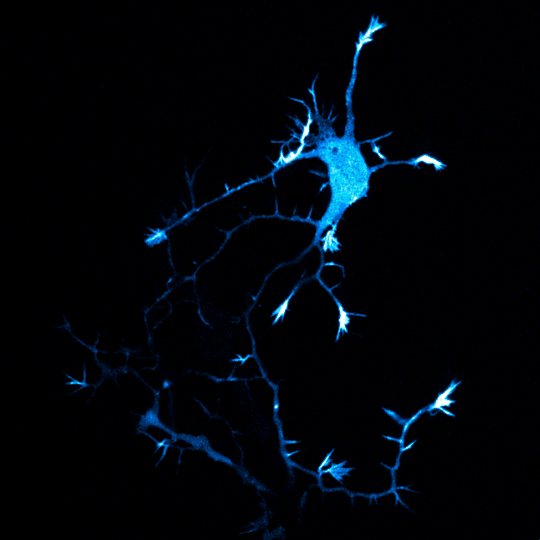
¿Es el fármaco ADUHELM una cura definitiva para el Alzheimer?
Esto es un tema que me ha suscitado mucha curiosidad y como familiar que ha visto de cerca la enfermedad de Alzheimer en un ser querido, parece una buena noticia, pero como científica interesada en el mundo #neuro no puedo estar en más desacuerdo con todo lo relacionado a este “nuevo tratamiento”.
🌐La enfermedad de Alzheimer es la forma más prevalente de demencia, con 50 millones de personas afectadas en todo el mundo. Esto significa que hay un caso reciente de Alzheimer cada 3 segundos y los científicos estiman que en 2050 esta comunidad aumentará a 152 millones.
🗯️Aunque se han desarrollado varios enfoques para combatir el Alzheimer, aún no se ha encontrado un tratamiento farmacológico exitoso que frene o detenga el daño y la destrucción de las neuronas, y sólo se utilizan terapias paliativas. Hasta que, en junio de 2021, la FDA aprueba Aduhelm (anticuerpo monoclonal humano) de la farmacéutica Biogen.
🤔Su aprobación ha generado mucha controversia, ya que hay escasez de datos #positivos que favorezcan la desaparición de la acumulación de proteínas beta-amiloide. Además, en algunos casos, los efectos secundarios pueden provocar graves lesiones neurológicas. Los estudios se contradicen unos y otros y esto solo me lleva a mí como científica y apasionada de buscar y contrastar información a #dudar de todo lo que veo y leo.
🟥En un último movimiento la #EMA, a 16 de diciembre de 2021, publica un artículo rechazando #Aduhelm como tratamiento para el Alzheimer ya que, en palabras de la agencia, “los beneficios de Aduhelm no superan sus riesgos y se recomienda denegar la autorización de comercialización”. Podéis leerlo aquí: https://www.ema.europa.eu/en/medicines/human/withdrawn-applications/aduhelm
Y la empresa retiró la solicitud de autorización de comercialización finalmente el 20 de abril de 2022.
✅En mi opinión, la EMA ha sido rigurosa, científicamente hablando. No se puede aprobar un tratamiento sencillamente porque haya una falta de uno para esa enfermedad en concreto. Sin embargo, si de verdad se ha visto una disminución de los “síntomas” se debería refinar la molécula para que los efectos sean más claros.
¿Vosotros qué haríais en una situación así? ¿Qué opináis sobre la FDA aprobando un tratamiento del cual no tenemos pruebas suficientes de que funcione? Os leo en comentarios 👇
#science#neuroscience#neuroscientist#chemistry#drug discovery#biology#aduhelm#alzheimers#u.s. fda#biogen
1 note
·
View note
Text
Sci-Hub? What's that? Pero eso qué é'?
Hallo!
But do you also write on a Saturday? YAAAYSSS. Today I dare to write because of the big stir that was created in the scientific community by a comment of Alexandra Elbakyan to the journal Nature.
🟥For those who don't know her, Alexandra Elbakyan is a software developer, neuroscientist, and.... (drum roll) founder of SCI-HUB (in 2011).
🟥 What is Sci-Hub? Well, the people who use it say it's like the modern-day library of Alexandria. Sci-Hub is like an extensive internet library of all the articles, many of them scientific, that are published in journals and are freely accessible (FREE). Or at least Alexandra makes them freely accessible with a click on her platform. She does what typically costs us, scientists, thousands of euros for free.
But.... wait... does scientific reading articles cost money?
The answer depends. If they are OpenAccess journals, it is free, but if they are not, an article will cost between 30-40€ at the cheapest and up to 80€ depending on the journal in which it is published. Most of the articles are among the latter.
Now that you know what SciHub is, I'll explain the hype:
✳️Nature (let's remember that it is a paid magazine) published a somewhat peculiar article about a class action lawsuit against Sci-Hub since this is considered a pirate website in several countries worldwide (not to say all). So I leave you the article's DOI so you can enter it in Sci-Hub and read it (10.1038/d41586-021-03659-0😉).
✳️Well, Alexandra answered them this way (in the picture), and I invite you to read it carefully👇.

🟥I'm not going to give more information or say anything else (the research work is up to you). So instead, I want you to share what Alexandra's answer generates with you in the comments👇. I'd love to read you.
🟥To finish, I want to leave you a little piece of my thesis. In the acknowledgments part, I wrote:
To Alexandra Elbakyan, for making my thesis writing more accessible and faster.
✅I also add that science should not be for a few.
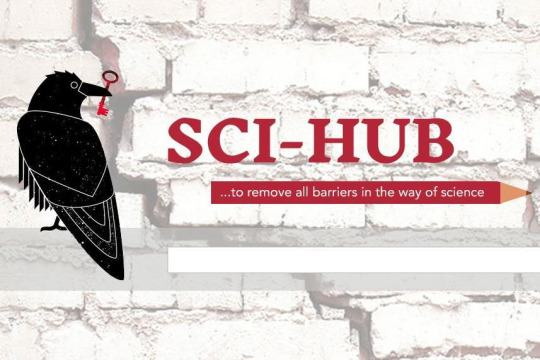
Hallo!
Pero, ¿también escribes un sábado? SIIIIII. Hoy me atrevo a escribir por el gran revuelo que se creó en la comunidad científica un comentario de Alexandra Elbakyan hacia la revista Nature.
🟥Para los que no la conocéis Alexandra Elbakyan es desarrolladora de software y neurocentífica y…. (redoble de tambores) fundadora de SCI-HUB (en 2011).
🟥 ¿Qué es Sci-Hub? Pues la gente que lo usamos decimos que es como la biblioteca de Alejandría de los tiempos modernos. Sci-Hub simplemente es como una gran biblioteca en internet de todos los artículos, muchos de ellos científicos, que se publican en revistas y que son de libre acceso (GRATUITO). O al menos Alexandra hace que sean de libre acceso con un click en su plataforma. Lo que normalmente nos cuesta a los científicos miles de euros, ella lo hace gratis.
Pero… espera… ¿leer artículos científicos cuesta dinero? La respuesta es depende, si son revistas #OpenAccess es gratuito, pero si no lo son, entonces un artículo costará entre 30-40€ lo más baratos y llegando a los 80€ alguno dependiendo de la revista en la que esté publicado. La mayoría de los artículos están entre éstas últimas.
Ahora que sabéis lo que es SciHub os explico el revuelo que se montó:
✳️Nature (recordemos que es una revista de pago) publicó un artículo un tanto peculiar sobre una demanda colectiva que hay sobre Sci-Hub, ya que ésta es considerada una web pirata en varios países del mundo (por no decir todos). Os dejo el DOI del artículo para que lo introduzcáis en Sci-Hub y podáis leer el artículo (10.1038/d41586-021-03659-0😉).
✳️Pues Alexandra les contestó de esta manera (en la foto) y os invito a que lo leáis detenidamente👇.

🟥No voy a dar más información ni decir nada más (el trabajo de investigación queda en vosotros), solo quiero que compartáis lo que os genera la respuesta de Alexandra en comentarios. Me encantaría leeros.
🟥Para terminar, os quiero dejar un trocito de mi tesis. En la parte de agradecimientos escribí:
To Alexandra Elbakyan, for making my thesis writing easier and faster.
✅Además, añado que la #ciencia no debería ser para unos pocos.
#science#scihub#libgen#alexandra elbakyan#ciencia#free use#journal#papers#scientific writing#scientists
4 notes
·
View notes
Text
Lab notebooks in science!
Today I will talk about the dilemma of taking your lab notebooks when you are working or doing your Ph.D. home to avoid plagiarism or because you don't trust people because you think they are going to do something wrong. But... What are you telling me?
What you hear, or in this case, read. As I said, I am a doctor in organic chemistry (BOOM!🤯). That is, I have dedicated myself to synthesizing chemical compounds to, in my case, find a cure for certain neurodegenerative diseases. The topic I am going to write about today is the result of an unpleasant experience in the past.
I used to work in a laboratory a long time ago, almost in the Paleolithic era, due to the quality of the materials we had. We took our notebooks home for different reasons: to write a memoir out of distrust or because of plagiarism. Then, one day, a reaction started to come out of the flask, it wasn't my reaction, and I couldn't find the notebook on my partner's table, and I didn't know what to do. Do I pour acid? Base? Heat it? Freeze it? Wipe it with paper? Run? What do I do?
Panicking was the only thing I did. Later in the calm, our supervisor explained the importance of leaving the notebooks in the lab open by the page of the reaction being done so that we would know what to do at every moment of danger. Later in another lab, I learned that even with the notebook open, people still panic, and the most effective thing to do is to put the reaction on top of the glass of the fume cupboard with a sheet of paper, more or less like this:

This sheet is the one we used during the Ph.D. By the second language, you can get an idea of where I did it. The complete reaction is written in the space with solvents and some comments. Significant also the safety symbols to be more careful when there are carcinogenic or radioactive reactions. The sheet should never cover your field of vision where you work, so it is placed as high as possible.
If you need the sheet, ask me for it. I will gladly send it to you in the format that suits you best.
And you, do you take the notebook home? Has something similar happened to you? Did you know this safety sheet trick? Do you have reaction safety sheets in your laboratories?
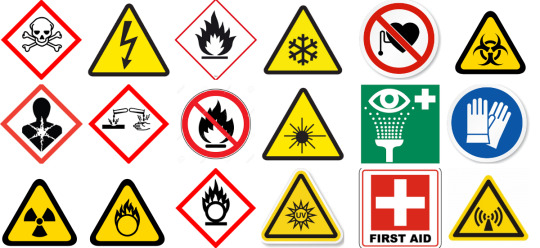
Hoy hablaré sobre el dilema de llevarse los cuadernos de laboratorio, cuando trabajas o estás haciendo el doctorado, a casa para evitar plagios o porque no te fías de las personas porque crees que van a hacer algo malo. Pero… ¿Qué me estás contando?
Lo que oyes, o lees en este caso. Como dije soy doctora, en química orgánica (¡BOOM! 🤯). Es decir, me he dedicado a sintetizar compuestos químicos para, en mi caso, encontrar una cura para ciertas enfermedades neurodegenerativas. El tema del que voy a escribir hoy, es resultado de una experiencia no agradable en el pasado.
Trabajaba yo en un laboratorio hace muchísimo tiempo, casi en el paleolítico por la calidad de materiales que teníamos. Todos los que estábamos allí nos llevábamos los cuadernos a casa por distintas razones, para escribir una memoria, por desconfianza o por el tema del plagio. Un día, una reacción comenzó a salirse del matraz, no era mi reacción y no encontraba el cuaderno encima de la mesa de mi compañero, y no sabía qué hacer. ¿Le echo ácido? ¿base? ¿caliento? ¿congelo? ¿limpio con papel? ¿corro? ¿qué hago?
Entrar en pánico es lo único que hice. Después en la calma, nuestra supervisora nos explicó la importancia de dejar los cuadernos en el laboratorio abierto por la página de la reacción que se estaba haciendo, así de esta manera sabríamos qué hacer en cada momento de peligro. Más adelante en otro laboratorio aprendí, que incluso con el cuaderno abierto, la gente entra en pánico igualmente y lo más efectivo es poner la reacción arriba del cristal de la vitrina con una hoja más o menos así:

Esta hoja es la que utilizábamos durante el doctorado, por el segundo idioma podéis haceros a la idea de dónde lo realicé. Se escribe la reacción completa en el espacio con disolventes y algún comentario sobre la reacción. Muy importante también los símbolos de seguridad para tener más cuidado cuando haya reacciones carcinogénicas o radiactivas. La hoja nunca debe tapar tu campo de visión en el que trabajas, por lo que se coloca lo más alto posible.
Si necesitas la hoja, sólo tienes que pedírmela. Te la enviaré encantada en el formato que más te convenga.
Y vosotros, ¿os lleváis el cuaderno a casa? ¿os ha pasado algo igual? ¿sabíais este truco de la hoja de seguridad? ¿hay hojas de seguridad de reacciones en vuestros laboratorios?
3 notes
·
View notes